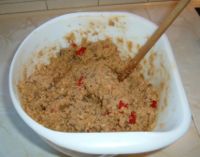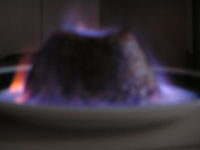Christmas pudding is the dessert traditionally served on Christmas day in Britain and Ireland, as well as in some Commonwealth countries. It has its origins in England, and is sometimes known as plum pudding, though this can also refer to other kinds of boiled pudding involving a lot of dried fruit.
Contents |
Basics of Christmas pudding
Many households have their own recipe for Christmas pudding, often handed down the family.
Christmas pudding is a boiled, or rather steamed, pudding, massively heavy with dried fruit and nuts, and usually made with suet. It should be very dark in appearance - effectively black - and moist with brandy and other alcohol (some recipes call for dark beers such as mild, stout or porter). In Peru, some families use Pisco.
Traditionally, Christmas puddings were boiled in a pudding cloth, and they are often represented as round, but at least since the beginning of the twentieth century they have usually been prepared in basins.
The wish and other traditions of Christmas pudding
Traditionally puddings were made on or immediately after the Sunday "next before Advent", i.e. five weeks before Christmas. The Collect for that Sunday in the Book of Common Prayer of the Church of England, as it was used from the sixteenth century (and still is in traditional churches), reads:
- "Stir up, we beseech thee, O Lord, the wills of thy faithful people; that they, plenteously bringing forth the fruit of good works, may by thee be plenteously rewarded; through Jesus Christ our Lord. Amen"
The day became known as "Stir-up Sunday". Traditionally everyone in the household, or at least every child, gave the mixture a stir, and made a wish while doing so.
It was common practice to include small silver coins in the pudding mixture, which could be kept by the person whose serving included them. The usual choice was a silver 3d piece, or a sixpence. The coin was believed to bring wealth in the coming year. However this practice fell away once real silver coins were not available, as it was believed that alloy coins would taint the pudding. The practice has largely stopped for reasons of safety and liability.
Other tokens are also known to have been included, such as a tiny wishbone (to bring good luck), a silver thimble (for thrift), or an anchor (to symbolise safe harbour).
Once turned out of its basin, the Christmas pudding is traditionally decorated with a spray of holly, and it may be doused in brandy, flamed (or 'fired'), and brought to the table ceremonially - where it may be greeted with a round of applause. In some houses the lights are turned out as the pudding is brought in amid a halo of purple brandy flames (this is related to the Christmas tradition of snap-dragons). It can be eaten with hard sauce, brandy butter, rum butter, cream (lemon cream is excellent) or custard and is often sprinkled with caster sugar (the fall of the sugar on triangular slices resembling the fall of snow on a pitched roof, or snowy mountain tops).
After Christmas, Christmas pudding
Christmas puddings have very good keeping properties and many families keep one back from Christmas to be eaten at another celebration later in the year, often at Easter. Some take the practice so far as to make each year's pudding the previous Christmas. Others claim that this impairs the flavour, but admit that a well-made pudding will keep at least adequately for a year.
Christmas puddings can be bought ready made and cooked, but unless they come from a luxury shop these are likely to be a poor substitute for a home-cooked pudding. Nowadays, many people find the Christmas pudding too rich and heavy (especially after lots of rich food on the morning of Christmas, then a starter and a large main course for the main meal), but most families have at least one member who will demand that a "proper" Christmas pudding be cooked.
See also
Categories: Christmas food




